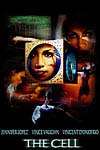
|
|
Tarsem's film starts off on the genre's usual foundation. A serial killer (Vincent D'Onofrio) kidnaps and encloses women in an isolated cell, a sort of aquarium that is gradually filled with water under the eye of a camera. An FBI agent (Vince Vaughn) is on his heels. But where this type of film generally turns into the manhunt for the killer, The Cell takes another direction. Rapidly discovered but in a coma, the criminal hides a last victim that the police must find quickly and save. So the FBI calls on a child psychologist, Catherine Deane (Jennifer Lopez), who thanks to a new advanced technology, can enter the mind of her patients. Catherine Deane is now tasked with entering the mind of a serial killer in order to find his latest victim. From this moment on the film compares two complementary stories or dimensions: the imagination (that haunts the mind of the killer) and the reality (a race against time to save the victim). The success of the film resides in a perfectly chiseled script that uses the "symbolic" as the key to the enigmas posed. Thus The Cell is far from being a purely visual film without substance, as it has been criticized for by some. To the contrary, the visuals are in the service of the symbolism, which won't escape those who only skim over the surface of the beautiful images. In the opening scene Lopez, dressed in white, is on a horse in the middle of the desert. She dismounts, and the horse is transformed into a pawn. She goes to join a child standing next to a boat run into the sand. The child is savage and flees the psychologist. In fact, Lopez is in the mind of her young patient, trying to approach him to treat his autism. The desert symbolizes this child's isolation from the world. He can't communicate and the circular tracks in the sand create an interior spiral in which he is prisoner. The boat stuck in the sand is reminiscent of Werner Herzog's Fitzcarraldo, in which the main character of the same name has the insane idea of moving a boat over a mountain in the middle of the jungle. The film debuts with the pessimist fact that the child only has a small chance of leaving this state. The apparent tranquility of the child's mind is directly opposed to the nightmarish vision in the mind of kidnapper Carl Stargher. Where the desert, brilliant light, and Catherine's white wedding-like dress symbolized the innocence and purity of the child, the gloomy colors, menacing encounters, and Lopez's sadomasochistic suits represent Carl Stargher's hostile mind, permanent torture, and the unhealthy urges. This is where the director's talent intervenes. He succeeds by creating images of the horror of the killer's mind through admittedly artistic visuals, but especially by a strong symbolic dimension. Tarsem's images, a TV ad and video director (Levi's, "Losing My religion" by REM) come from a great aestheticism, in beauty as well as in horror. His style could be previewed in REM's famous video allied with the industrial imagery of Nine Inch Nails and surrealism, with a dose of kitsch (somewhere between Jean-Paul Gaultier and the photographs of Pierre & Gilles). The symbols strongly borrow from the Surrealist painters, in particular Salvador Dali and Max Ernst, as well as from David Lynch's imagination and religion. One notices a theme dear to the surrealists, the omnipresence of animals in the middle of infinite scenery, as well as the presence of deformed characters and claustrophobic rooms reminiscent of the Twin Peaks series. So psychologist Catherine Deane will be confronted by a Carl Stargher as an innocent child (another parallel with the autistic boy) and a victim of the adult Stargher, who takes on a diabolical form. All of these elements have but one goal, to represent the state of torture in which Stargher finds himself: the hell of the damned (an allusion to The Garden of Delights by Hieronymus Bosch). In a key scene, Lopez makes contact with the young Stargher who has hidden behind a horse protecting him. This horse, a symbol of freedom and sexuality not only for the surrealists but also throughout human history, is suddenly sliced into still pulsating pieces by panes of glass. More than a vulgar display of butchery, this quartered horse reflects the bursting of symbols it represents in Stargher's head. Freedom is out of the question for the boy, while in the autistic child's case, the horse, like the boat, lets in a glimpse of hope of a way out. In Stargher's world, the horse is cut into pieces and the women he kills resemble automatons he can control. Neither the horse nor the women have the possibility to exist in their true free nature in his mind. This mental torture that affects him is so strong that she finds a physical representation in the malaises he endures. This suffering, more of an allegory of evil that he carries within him, is also a divine punishment. He must suffer for his sins, and he knows it: from the sadistic ceremony to which he gives himself up and the presence of rings hanging from his back. Suspended by chains above his victim, he reaches a sort of orgasm. His suspended position and the suffering from the rings planted in his flesh symbolize the crucifixion and stigmata of Christ. Just like Him, this crucifixion will create resurrection. In effect, though Stargher's acts are monstrous, in his mind they have the purpose of salvation. The killer is a sort of eunuch traumatized by another monster, his father. He is asexual as he repudiates men and their monstrosity. So he kidnaps women, the only pure beings in his eyes, in order to save them from men. This is also why he kills them with water; the element in which he was plunged for his baptism and so a symbol of purity. In an identical intention of purification, the cadavers are bleached. So Stargher absorbs all of the sins of his father and man in general. Like Christ he sacrifices himself in an ultimate crucifixion. The intervention of the Virgin Lopez who brings him resurrection and redemption in the end is a logical conclusion. The divine role of Lopez in nonetheless confirmed in her role in the machine. She is suspended, facing the upwards and towards paradise, while D'Onofrio is suspended face down and thus towards hell. Though this conclusion may be logical it would be wrong to see some sort of pro-Stargher message. The film, though bringing Stargher redemption, does not excuse him for his acts. As Vaughn's character mentions, "Not every abused child grows up to be a monster", a phrase that resonates with his own painful personal experience. So the film can finish up and return to the child from the beginning. Catherine Deane now has the strength and experience necessary to save him from this desert "of expression". She creates a solid path to the boy (symbolized by the two ends of her dress tied to the trees) so he can reach the boat, pluck it from the sand, and put it in the tree. The child is no longer stuck in non-communication, and may return to the world. The Cell may conclude. As for the film itself? Tarsem uses saturated live colors to contrast between good and evil, and his stylized direction is an aesthetic success. The actors themselves are subdued. In any case they are only pawns in the middle of all of these artistic images with strong symbolic value. Jennifer Lopez is neither Jody Foster nor Julianne Moore (that would have been too obvious), but fits well in a latex suit and has a sweetness in line with the character, while Vincent D'Onofrio only has a bit of screen time and Vince Vaughn lacks the firm hand for an FBI agent. The Cell is original, clever, and well-controlled film that's easy to be locked into if given the sustained attention it merits.
|
|

